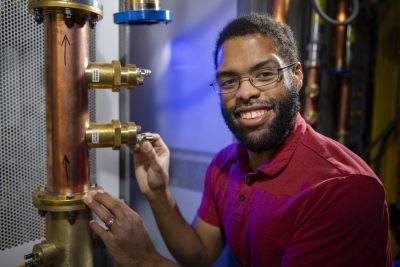
Brian Vaughn examines the output directional coupler for a PIP-II solid state amplifier. Photo: Ryan Postel, Fermilab
How long have you worked at the U.S. Department of Energy’s Fermi National Accelerator Laboratory?
I’ve been working at Fermilab just under two years, and I’ve been moving around a lot. I have a hand in PIP-II and some Booster upgrade efforts for the PIP-II injection energies. I’m also working on an effort to make a Main Injector superconducting cavity, which is very fun, because it’s very hard, and no one’s ever been able to do it. I don’t know if I can, but I’m trying.
Of the projects you’re working on, which is your favorite?
I would say the most fun I’ve had is with that Main Injector superconducting cavity, just because I’ve had to learn so much in such a small amount of time. I learn by doing: I can’t necessarily just read something and retain it; I have to apply it over and over before it starts making sense to me. I’ve been learning so much about superconducting properties and all the challenges that go with making cavities [that can store an extraordinary amount of energy with very little power loss].
I think I’ve gotten a lot more skills that are readily applicable to all the things that we do, so I would say that’s been the most rewarding project thus far.
What’s the biggest challenge to making a superconducting cavity for the Main Injector?
The biggest challenge is that superconductivity requires a very specific set of conditions to be maintained at all times, like low temperatures for example. There are tunable superconducting cavities out there, but they don’t have a wide enough tuning bandwidth to be able to handle what the Main Injector needs. So right now, we have to use normal conducting cavities to handle that bandwidth and tuning speed. I’m trying to fix that.
[It’s] going to be a big challenge, but if we can figure it out, we’ll be able to reduce the number of cavities needed to accelerate the beam by an order of magnitude, which is extremely beneficial for high-intensity beam stability. Having many cavities places a pretty hard limit on your beam intensity because the cavities act back on the beam. Reducing the number of cavities by the projected amount makes that limit go away, which would be a game-changer for machines all over the world.
Is there anything about working at Fermilab that you particularly enjoy?
If you’d told me five years ago I’d be working on particle accelerators, I never would have believed it because I just thought that it was so far outside of my purview. But it really isn’t. I have so many skills that are applicable to all these things. I’m super glad about that because in my previous jobs, I was just doing the same thing over and over again. There, I didn’t get to work at the edge of my competence, which is why I got a Ph.D.
Here, I’m pushed in so many different directions at once. Usually, that sounds like a bad thing, but I get to expand in ways that I don’t imagine I’d be able to do in many other places. I’m very grateful for that.
Who are some of the role models you’ve had in your life?
My AP Physics teacher in high school. His name was John Taska. He made the class so very engaging. At that point, I kind of knew that I wanted to do something STEM-ish, but I didn’t have my field nailed down quite yet. He made the electrical engineering portion of the class one of the most fun I ever had in any class in high school, and I was like, “I need to be this guy. I need to do what this guy did,” because it was just so compelling. It clicked for me. So, I’m very, very grateful for Mr. Taska, for illuminating that pathway for me.
And Katherine Johnson — she’s my biggest role model in the sphere of Black historical figures. She was subjected to social obstacles that were immensely more pervasive than I can imagine. There’s still a ways to go, but things then were not where they are now. I’ve been afforded massive amounts of help and opportunities that she did not receive, and yet, look at what she accomplished. She was just as responsible for [putting] the first American in orbit and then the lunar landing and everything after that as anyone else at NASA. Her genius, her grit and her perseverance and grace are awe-inspiring. If she could do that with the obstacles that she was faced with, I can try my best.
What do you like to do outside of the lab?
I’m an amateur martial artist, and I like engaging with that physicality.
I also like watching documentaries about NASA a lot. The space shuttle is my favorite engineering project ever: I have a poster of the space shuttle in my office; it’s my Zoom profile picture; I love that thing so terribly much. I went to the Houston Space Center recently while attending the United States Particle Accelerator School. I cried twice; I’m not ashamed. Just engaging with engineering marvels and space type stuff, I love doing that.
Fermi National Accelerator Laboratory is supported by the Office of Science of the U.S. Department of Energy. The Office of Science is the single largest supporter of basic research in the physical sciences in the United States and is working to address some of the most pressing challenges of our time. For more information, please visit science.energy.gov.
